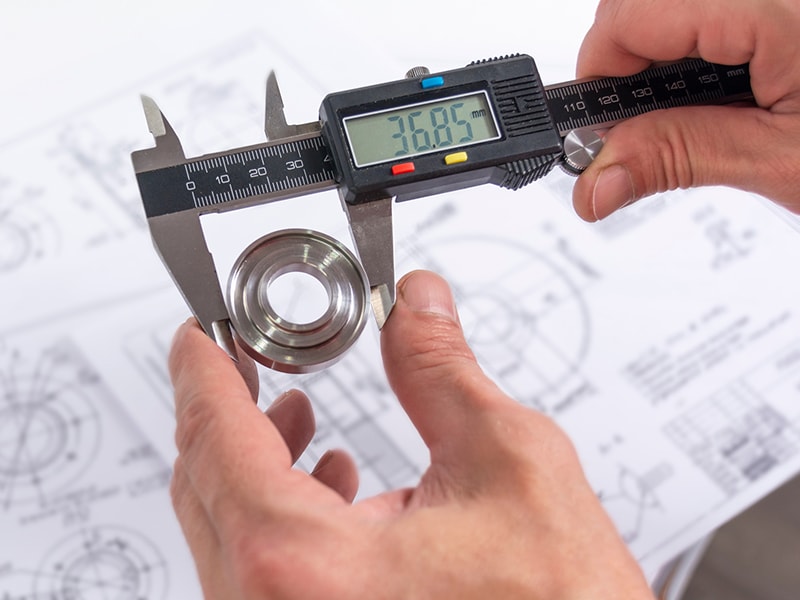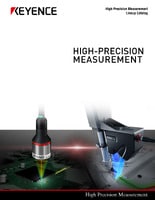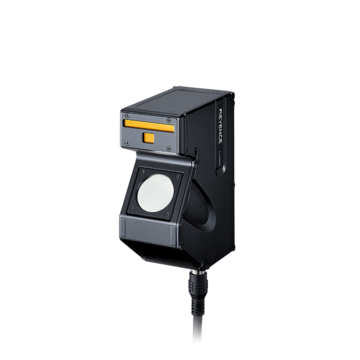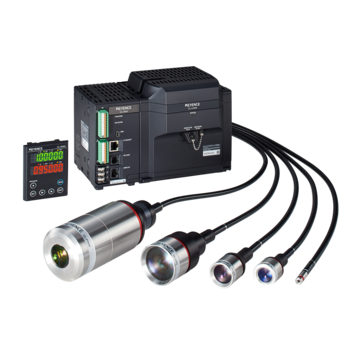Measurement Sensors
Dimension Measurement
Displacement Measurement
International System of Units (SI)

The principle behind the International System of Units is to provide the same values for measurements such as length, weight, and time no matter where in the world measurement is performed. The units used in this system are referred to as “SI units.” The system was established at the 1960 General Conferences on Weights and Measures (CGPM). The abbreviation “SI” stands for “Le Système International d'Unités.”
The International System of Units comprises the following three categories.
Base Units
| Amount | Unit name | Unit symbol | Definition | ||
|---|---|---|---|---|---|
|
Length
|
Unit name
Meter
|
Unit symbol
m
|
Definition
The distance traveled by light in a vacuum in 1/299792458 second.
|
||
|
Weight
|
Unit name
Kilogram
|
Unit symbol
kg
|
Definition
This is the unit for weight. The mass of the international prototype kilogram.
|
||
|
Time
|
Unit name
Second
|
Unit symbol
s
|
Definition
The duration of 9192631770 periods of the radiation corresponding to the transition between the two hyperfine levels of the ground state of the cesium 133 atom.
|
||
|
Current
|
Unit name
Ampere
|
Unit symbol
A
|
Definition
The constant current which, if maintained in two straight parallel conductors of infinite length, of negligible circular cross-section, and placed 1 m apart in vacuum, would produce between these conductors a force equal to 2×10-7 newtons per meter of length.
|
||
|
Thermodynamic temperature
|
Unit name
Kelvin
|
Unit symbol
K
|
Definition
1/273.16 of the thermodynamic temperature of the triple point of water.
|
||
|
Substance amount
|
Unit name
Mole
|
Unit symbol
mol
|
Definition
The amount of substance of a system that contains as many elementary entities as there are atoms in 0.012 kilogram of carbon 12. (Limited to objects with clarified composition.) Elementary entities are subatomic particles that compose matter and energy.
|
||
|
Luminosity
|
Unit name
Candela
|
Unit symbol
cd
|
Definition
The luminous intensity, in a given direction, of a source that emits monochromatic radiation of frequency 540×1012 hertz and that has a radiant intensity in that direction of 1/683 watt per steradian.
|
||
Supplementary Units
| Amount | Unit name | Unit symbol | Definition | ||
|---|---|---|---|---|---|
|
Plane angle
|
Unit name
Radian
|
Unit symbol
rad
|
Definition
Radian describes the plane angle subtended by an arc of a circle with the same length as the radius of that circle corresponds to an angle of 1 radian.
|
||
|
Solid angle
|
Unit name
Steradian
|
Unit symbol
sr
|
Definition
A steradian is a solid angle at the center of a sphere subtending a section on the surface equal in area to the square of the radius of the sphere.
|
||
We’re here to provide you with more details.
Reach out today!

Derived Units
Derived units are a combination of base units and supplementary units and the mathematical symbols of multiplication and division.
| Amount | Unit name | Unit symbol |
|---|---|---|
|
Area
|
Unit name
Square meter
|
Unit symbol
m2
|
|
Volume
|
Unit name
Cubic meter
|
Unit symbol
m3
|
|
Speed
|
Unit name
Meter per second
|
Unit symbol
m/s
|
|
Acceleration
|
Unit name
Meter per second squared
|
Unit symbol
m/s2
|
|
Wavenumber
|
Unit name
Reciprocal meter
|
Unit symbol
m-1
|
|
Density
|
Unit name
Kilogram per cubic meter
|
Unit symbol
kg/m3
|
|
Current density
|
Unit name
Ampere per square meter
|
Unit symbol
A/m2
|
|
Magnetic field strength
|
Unit name
Ampere per meter
|
Unit symbol
A/m
|
|
Concentration (of amount of substance)
|
Unit name
Mole per cubic meter
|
Unit symbol
mol/m3
|
|
Specific volume
|
Unit name
Cubic meter per kilogram
|
Unit symbol
m3/kg
|
|
Luminance
|
Unit name
Candela per square meter
|
Unit symbol
cd/m2
|
Some derived units are given unique names.
| Amount | Unit name | Unit symbol | Composition |
|---|---|---|---|
|
Frequency
|
Unit name
Hertz
|
Unit symbol
Hz
|
Composition
1Hz=1s-1
|
|
Force
|
Unit name
Newton
|
Unit symbol
N
|
Composition
1N=1kg・m/s2
|
|
Pressure, stress
|
Unit name
Pascal
|
Unit symbol
Pa
|
Composition
1Pa=1N/m2
|
|
Energy, work, amount of heat
|
Unit name
Joule
|
Unit symbol
J
|
Composition
1J=1N・m
|
|
Power, radiant flux
|
Unit name
Watt
|
Unit symbol
W
|
Composition
W=1J/s
|
|
Electric charge, amount of electricity
|
Unit name
Coulomb
|
Unit symbol
C
|
Composition
1C=1A・s
|
|
Electric potential/electric potential difference, voltage, electromotive force
|
Unit name
Volt
|
Unit symbol
V
|
Composition
1V=1J/C
|
|
Resistance (electrical)
|
Unit name
Ohm
|
Unit symbol
Ω
|
Composition
1Ω=1V/A
|
|
Conductance (electrical)
|
Unit name
Siemens
|
Unit symbol
S
|
Composition
1S=1Ω-1
|
|
Magnetic
|
Unit name
Weber
|
Unit symbol
Wb
|
Composition
1Wb=1V・s
|
|
Magnetic flux density, magnetic induction
|
Unit name
Tesla
|
Unit symbol
T
|
Composition
1T=1Wb/m2
|
|
Inductance
|
Unit name
Henry
|
Unit symbol
H
|
Composition
1H=1Wb/A
|
|
Celsius temperature
|
Unit name
Degree Celsius
|
Unit symbol
°C
|
Composition
1t=T-To
|
|
Luminous flux
|
Unit name
Lumen
|
Unit symbol
lm
|
Composition
1lm=1cd・sr
|
|
Illuminance
|
Unit name
Lux
|
Unit symbol
lx
|
Composition
1lx=1lm/m2
|
Discover more about this product.
Click here to book your demo.

Reference Information
SI unit prefixes indicating integer powers of ten
| Factor | Prefix | Symbol | Factor | Prefix | Symbol |
|---|---|---|---|---|---|
|
1018
|
Prefix
exa
|
Symbol
E
|
10-1
|
Prefix
deci
|
Symbol
d
|
|
1015
|
Prefix
peta
|
Symbol
P
|
10-2
|
Prefix
centi
|
Symbol
c
|
|
1012
|
Prefix
tera
|
Symbol
T
|
10-3
|
Prefix
milli
|
Symbol
m
|
|
109
|
Prefix
giga
|
Symbol
G
|
10-6
|
Prefix
micro
|
Symbol
µ
|
|
106
|
Prefix
mega
|
Symbol
M
|
10-9
|
Prefix
nano
|
Symbol
n
|
|
103
|
Prefix
kilo
|
Symbol
k
|
10-12
|
Prefix
pico
|
Symbol
p
|
|
102
|
Prefix
hecto
|
Symbol
h
|
10-15
|
Prefix
femto
|
Symbol
f
|
|
10
|
Prefix
deka
|
Symbol
da
|
10-18
|
Prefix
atto
|
Symbol
a
|
Non-SI units
| Amount | Unit name | Unit symbol | Definition |
|---|---|---|---|
|
Time
|
Unit name
Minute
|
Unit symbol
min
|
Definition
1min=60s
|
|
Unit name
Hour
|
Unit symbol
h
|
Definition
1h=60min
|
|
|
Unit name
Day
|
Unit symbol
d
|
Definition
1d=24h
|
|
|
Plane angle
|
Unit name
Degree
|
Unit symbol
°
|
Definition
1°= (π/180) rad
|
|
Unit name
Minute
|
Unit symbol
′
|
Definition
1′= (1/60) °
|
|
|
Unit name
Second
|
Unit symbol
″
|
Definition
1″= (1/60) ′
|
|
|
Volume
|
Unit name
Liter
|
Unit symbol
l, L
|
Definition
1l=1dm3
|
|
Weight
|
Unit name
Metric ton
|
Unit symbol
t
|
Definition
1t=103kg
|
Evolution of SI Measurement Systems
The formation of the International System of Units, known as SI from the French Systeme International s’Unites, is the result of an international calibration towards a standardized system of measurements. The First Industrial Revolution brought about the rise of the textile industry and significant developments in metallurgy and coal mining.
However, most regions of the world relied on local units and standards that varied significantly from one place to another. Thus, the French introduced the SI measurement system as a revolutionary idea aimed at creating a uniform and logical system of measurement to appease the growing complexities of science, engineering, and trade, all of which demanded standardization.
The SI system went through several iterations between the 18th century and the 1960s before it was formally established during the 11th General Conference on Weights and Measures. This particular event defined the SI based on the physical constants of nature (seen in the table above) instead of tangible objects, thus ensuring greater precision and universality when using distance sensors.
We’re here to provide you with more details.
Reach out today!

Real-World Applications of SI Units
Since it provides universal and standardized measurements, the international unit system is widely used in modern industries and research and development settings. It enables effective communication between virtually everyone involved in the manufacturing of scientific processes.
Here are some key areas in which the SI system is used:
Engineering and Construction
Precision is the foundation of safety, efficiency, and innovation in engineering and construction, and the introduction of the international unit system enabled engineers worldwide to share and apply knowledge seamlessly. For example, architects rely on meters and kilograms to calculate structural integrity, while electrical engineers and technicians rely on amperes to design adequate and safe electrical systems.
Science and Research
The international unit system is the universal language of science since it enables researchers and scientists (and everyone else involved in manufacturing and R&D) to share and apply knowledge amongst themselves, regardless of the language they speak or the region they come from.
With its based and derivative units, the SI system became an indispensable tool for a whole range of scientific measurements, from measuring chemical reactions in moles to observing cosmic phenomena in kilometers and seconds with measurement sensors.
Healthcare and Medicine
Precision and accuracy are also very important in the medical and healthcare industries and often mean the difference between life and death. Dosages and other fluid measurements are mostly expressed in milliliters, or a thousandth of a liter, which is derived from a unit of volume (cubic meter).
One milliliter equals one cubic centimeter, and it’s a critical measurement in fluid administration, such as administering crystalloid solutions (IV fluids) and intravenous or intramuscular injections. Kilograms, the international unit of weight, is also important in the calculation of medication dosages, usually milligrams or milliliters of medication per kilogram of body weight.
Industry and Commerce
International trade and industrial efficiency also rely on the international system of measurement since it enables seamless interactions and transactions across the globe. The SI units are important in ensuring that products meet strict specifications for weight, dimensions, and production times.
For example, the food industry measures ingredients in grams and milliliters, while the electronics sector operates on volts and amperes (amps), and commerce relies on the SI system to standardize the measurement of goods, shipping volumes, and transportation distances—which are important for logistics and supply chain management.
Summary
The international unit system is more than just a technical framework; it’s a universal language of measurement that spans entire disciplines, cultures, and industries. Its evolution from a revolutionary idea to a universal standard reflects the societal endeavor for precision, understanding, and cooperation.
Are you ready to elevate your measurement and precision standards with non-contact measurement devices?
Contact KEYENCE now to see how our innovative solutions can help streamline your processes and boost your productivity.
Contact us to learn more about how our advanced technology can help take your business to the next level.
Contact Us
Related Products
Applications
Dimension Measurement
- Thickness and Width Measurement
- Step Height Measurement
- Inner and Outer Diameter Measurement
- Measuring Angles
- Meandering/Edge Measurement
Displacement Measurement
- Positioning and Stroke Length Measurement
- Vibration and Runout Measurement
- Deflection Measurement
- Measuring Eccentricity






